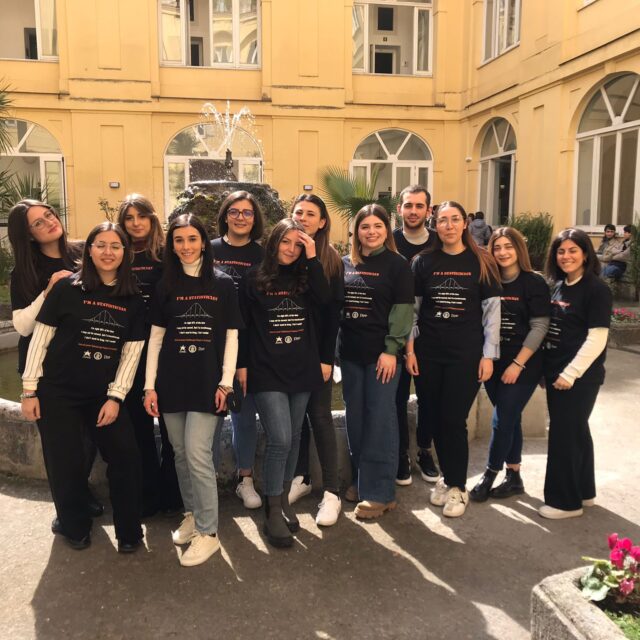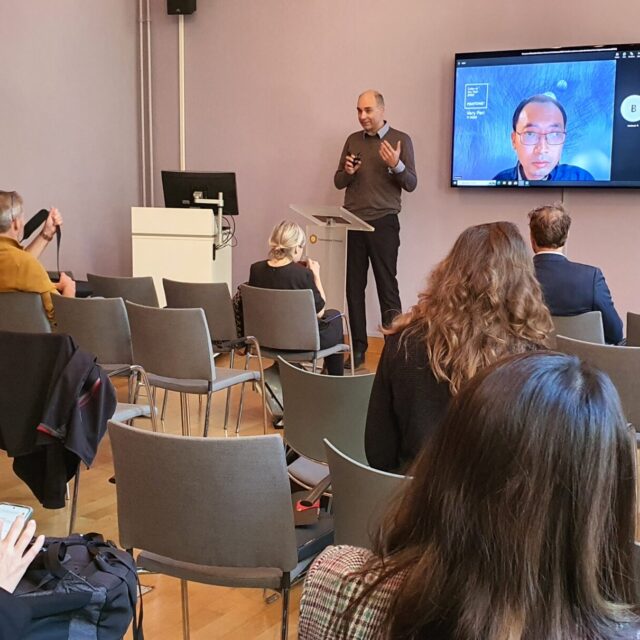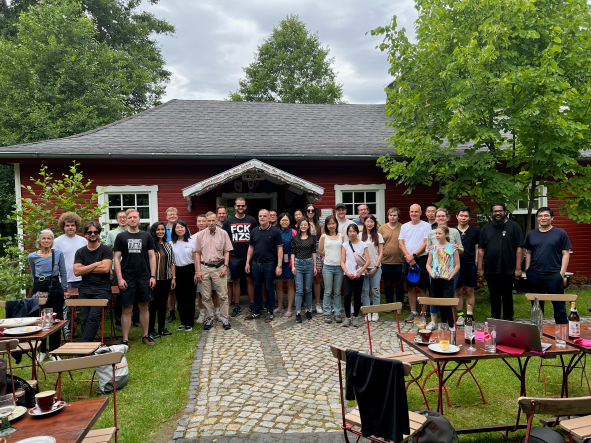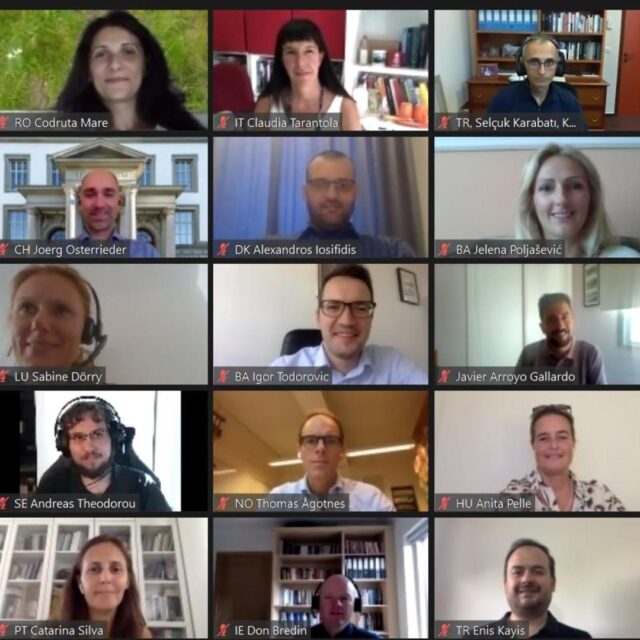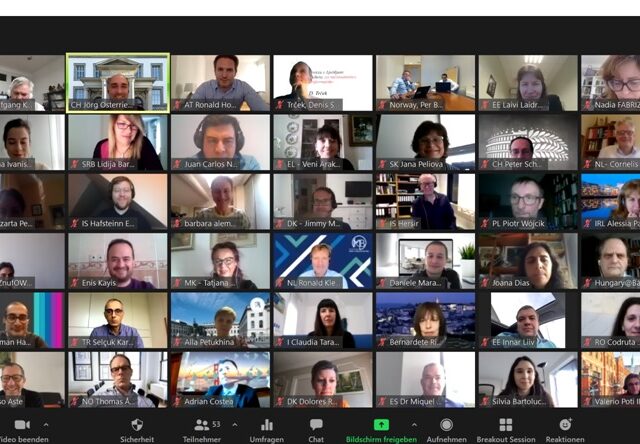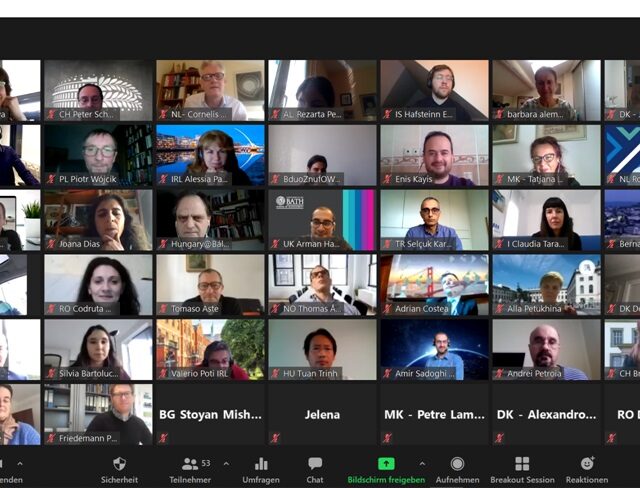Virtual Mobility Grants during 2023
Title: Advanced Analytics for sustainable finance: opportunities, risks, and inequalities
Grant Holder: Maria Iannario
Description of Activities and results:
Monitoring climate-related (and environmental) financial risks requires high data quality and granularity. However, these data are in short supply, with the exception of some data on a limited number of counterparties. The aim of the project was to take stock of the data needs arising from companies’ transition plans, net zero commitments and financial analyses, as well as those arising from international, European and national regulations and supervisory requirements. A preliminary study of some sources of “climate risk assessment data and methods” and a discussion with industry stakeholders enabled an initial scenario analysis. Secondly, a survey was conducted to gather information on the perception of ESG factors related to environmental, social and corporate governance. In particular, on the extent to which these constitute a relevant criterion for investment choices. The VMG aimed to take concrete measures to increase participation and create a strategy to involve stakeholders in the Action; it allowed for an analysis of the current objective condition based on real data and a self-assessment of one's own perception of involvement in the financial environment; and it allowed for an increase in the awareness of the younger generation on the importance of sustainable finance through their active involvement. The results included two scientific publications and the preparation of a reading article with the aim of communicating the main findings to a wider audience. The VMG involved 6 different countries: Italy, Kosovo, Turkey, Romania, Albania, Ireland.
Title: Economic Technology: Approaching AI in the Context of Policies and GDPR
Grant Holder: Liana Stanca
Description of Activities and results:
This VMG had as a main goal the update of the Stakeholders Engagement Strategy and the report for it. During its implementation, a series of events with the stakeholders were organized, in the form of conferences, workshops or presentations. Additionally, information on the relationship with the stakeholders and their involvement in the Action’s activities was collected from the Action members in order to report the latest activities in this respect and update the former strategy. To support the Action members in future collaboration with the stakeholders, a Stakeholder Engagement Strategy Prototype was constructed. One of the latest outputs related to the stakeholders’ engagement was the Techeconomics event, which gathered both national and international stakeholders, from the industry or from the regulators. Among them, we mention Kai Zenner, who gave an insightful update on the AI Act, which is so important in the field of our Action. Discussions with the stakeholders and their involvement in the Action’s activities have played a pivotal role in creating the new Stakeholders Engagement Strategy. The strategy is in continuous development, open for all members of the Action to add input in this respect. One of the notable outputs of the Action following the relationship with the stakeholders is the creation of the first Romanian FinTech Report in 2022, which was afterwards extended in 2023 to Romania and Bulgaria. Increased cooperation will lead to extending the FinTech report to other countries from the Action, in such a way as to create a more complex picture of the European Fintech environment. Additionally, several applications were submitted together with stakeholders, in order to increase the cooperation between academia and the business and regulatory sectors. The laters were also involved in the European survey that we conducted within the Action (coordinated by Maria Moloney) on the topic of GDPR vs. AI.
Title: Fintech, regulation, and cybercrime: opportunities arising from new technologies
Grant Holder: Monica Violeta Achim
Description of Activities and results:
The current VMG had as a goal to address D2, D8 and D10 of the COST Action CA19130 FinAI. D2 – Report on good examples and best practices for a transparent finance industry with guidelines to improve transparency, D8 – Position papers, aimed at regulators and policy-makers, on methodology (with examples of formal criteria) for testing AI techniques in real-time, and D10 – A position paper and roadmap on mitigating risks connected with the increased use of digital assets. All these deliverables were addressed within the final policy paper that I coordinated, entitled FinTech, regulation, and cybercrime: opportunities arising from new technologies. Researchers from seven countries worked together to deal with the deliverables. The research addresses the main issues that derive from the adoption of Financial Technologies (FinTech). We conduct a bibliometric and systematic literature review to assess the theoretical background on the subject matter based on the specialized literature, in a way that elucidates the reasons for the topic’s significance, ultimately revealing the research gap that this study intends to address. We discuss important topics related to FinTech, such as the advantages and risks, the huge need for regulation, the need for financial inclusion, the increased risks given to the financial transactions and how to face these cybercrimes within potential solutions. We also explore how financial companies can use new technologies to create new services and products using the large amount of data they have. We present the implications of our work for policy makers from different levels – microeconomic, macroeconomic, and European level.
Title: Business Intelligence Reporting by Linguistic Summaries
Grant Holder: Galena Pisoni
Description of Activities and results:
The aim of this VMG was to initiate a research collaboration on the wider topic of linguistic summaries and their application for business intelligence reporting in the financial sector. The team consisted of members coming from 5 different countries, Hungary, France, Slovakia, Serbia and Iceland, and foresaw production of 2 conference paper, one submitted for the upcoming information Systems conference 2024 (https://www.is-conf.org/), and one for the conference on Enterprise Information Systems (ICEIS) 2024. As part of this VMG as well, the team discussed and defined the structure for a journal paper on the topic of business intelligence and how one can improve transparency and reporting of outputs of AI models with Linguistic Summaries.
The Role of FinTech in Cashless Economy and Green Growth
Grant holder: Dr. Esra Kabaklarlı
Description of Activities and results:
This VMG outlines two main areas for the possible application of fintech to green growth and cashless economy. Firstly, panel data analysis, the impact of cashless economy on green growth will be applied to the selected countries in the years between 2012-2019. These selected countries are Argentina, Australia, Brazil, Canada, China, Hong Kong, India, Indonesia, Japan, Korea, Mexico, Russia, Saudi Arabia, Singapore, South Africa, Sweden, Switzerland, Turkey and United Kingdom. The random effect method will be used in panel data to analyses cashless economy impact on green growth. At the second stage of the VMG, survey on environmental awareness will be carried out with University students/staff to understand their level of environmental awareness, interest, and somehow their attitude. This survey, involving participants from CA19130 countries Egypt, Croatia, Albania, Iceland, Kosova, France and Turkey, attempted to be a micro-study that will help us better understand their awareness about the impact of their activities on the environment. Results: It is found that the regression coefficient of CO 2 productivity and number of cards per inhabitant are significantly positive, indicating that the cashless economy and carbon neutral production has a significant promoting effect on economic growth. Secondly It is found that the cash level of population variable (Banknotes and coins in circulation) passes the significance test of 10% confidence level, and the negative effect of economic growth.
Title: Exploring Research Visibility of the COST members: a Bibliometric Analysis of Topics
Grant Holder: Piotr Wójcik
Description of Activities and results:
In the team consisting of researchers representing five countries (Poland, Germany, Romania, Netherlands and Italy) we measured the results and content of research published through the FinAI COST action 19130. In particular, we performed this analysis with respect to specific topics that relate to important deliverables of our action, i.e. “risk of using digital assets” (see deliverable 10), “stress tests for AI evaluation” (deliverable 11), and “finance failed trials” (deliverable 12). We analyzed all publications of the participants of our COST Action scrapped from Google Scholar at the end of March 2023. Out of the total number of 216 Action participants for that moment, 51 did not have a google scholar profile. Therefore, finally we took into account the publications of 165 unique researchers. We applied some additional filtering rules. As the Action focuses on the applications of artificial intelligence in finance including the risks related to digital assets, we limited our sample to publications not earlier than 2010 (2009 is the year of the birth of bitcoin). In addition, as google scholar profiles might include not only research but also didactic materials (e.g. handouts for students) we limited our interest to the records that have non-empty journal name, which in case of google scholar
profile also includes phrases like “working paper”, “proceedings”, etc. To classify articles into topics we applied the state-of-art BERTopic algorithm, i.e. a transformer-based pre-trained language model based on the word embeddings. In a nutshell, embeddings are contextual representations of text. Embedded documents are represented in a vector space which enables comparing them semantically. Specifically, the most popular variants of the embeddings are Generative Pre-trained Transformer (GPT) and Bidirectional Encoder Representations from Transformers (BERT). In accordance with its name, BERTopic algorithm uses a variant of the latter. Precisely, it applies Sentence Bidirectional Encoder Representations from Transformers (Sentence-BERT). As the analyzed documents were written in different languages, we applied a multilingual variant of BERTopic. Parameters of the BERTopic algorithm were optimized using topic coherence measures, i.e., UCI, UMass, UCI-NPMI. Cosine similarity which takes values between -1 and 1, was used for identification of topics’ embeddings that were most similar to certain phrases: “risk of using digital assets”, “stress tests for AI evaluation”, “failed trials”. In the first part of the analysis we focused on the titles of articles. In our database there were 8,066 unique records representing scientific publications from 2010 onwards with non-empty titles. In addition, we extended the analysis on article descriptions (abstracts). In this part there were 5,485 unique records representing scientific publications with non-empty description (abstract) from the period 2010-2023. The results of the analysis offer a comprehensive view of the portfolio of created articles and working papers and its topic classification, leading to important benefits for FinAI-related institutions across the European Union. The Action participants will gain valuable insights into how established COST teams engaged in collaborative research can enhance their future publication output, how well the most important Action topics were covered in their research and what are the other emerging topics that can lead to future joint projects proposals. Last, but not least, comprehensive analysis of the scientific output of the Action so far would give interesting insights for the last deliverable of the Action which is “an edited volume containing scientific achievements of the Action”.
Title: An Overview – Stress Test Designs for the Evaluation of Ai and Ml Models Under Shifting Financial Conditions to Improve the Robustness of Models
Grant Holder: Jörg Osterrieder
Description of Activities and results:
Evaluating and Enhancing AI and ML Model Robustness
Objective: To assess and improve the robustness of AI and ML models in the financial sector under varying financial conditions.
Methodology: Conducted a comprehensive analysis of existing AI and ML models in finance.
Implemented advanced stress testing designs, focusing on scenario development, input variation, and performance metrics.
Results: Insights into AI and ML Model Performance
1. Enhanced Predictive Accuracy: Found that AI and ML models, when subjected to rigorous stress tests, displayed an enhanced ability to predict financial risks under diverse conditions. Identified key factors contributing to model resilience.
2. Regulatory Compliance and Challenges: Analyzed the compliance of these models with Basel Committee guidelines and other regulatory frameworks. Highlighted the challenges in balancing high predictive performance with regulatory standards.
3. Stress Testing Methodologies: Evaluated various stress testing methodologies for their effectiveness in assessing and improving model robustness. Proposed new strategies for stress testing that can be adopted by financial institutions.
4. Policy and Governance Implications: Detailed the implications of these findings for policymakers and financial institutions. Emphasized the need for adaptive strategies in risk governance to accommodate AI and ML models.
Future Directions and Recommendations: Recommended further research into AI and ML methodologies to continuously adapt and improve models in line with evolving financial landscapes. Advocated for a collaborative approach involving academics, industry practitioners, and policymakers to ensure the development of robust, efficient, and transparent financial systems.
Title: A position paper and roadmap on mitigating risks connected with the increased use of digital assets
Grant Holder: Jörg Osterrieder
Description of Activities and results:
Activities conducted during this VMG had as a main goal to treat the topic of risk mitigation in digital assets, by exploring the transformative impact of cryptocurrencies, tokenized securities, stablecoins, NFTs, and CBDCs on financial markets. This, because the emergence of digital assets has initiated a significant transformation in the global financial ecosystem. Technological drivers – key technologies like blockchain, distributed ledger technology (DLT), and smart contracts are at the forefront of this change. We address the following aspects:
1. Digital Assets – Evolution, Types, and Impact. For this, we analyzes the journey of digital assets from novel concepts to essential elements in modern finance, explore various digital assets, focusing on their distinct characteristics and use cases, examine the role of blockchain, DeFi, and NFTs in shaping the development of digital assets.
2. Regulatory Landscape and Challenges. The paper addresses the current state of adoption and regulation by investigating the adoption trends and regulatory status of digital assets globally,
highlighting different regulatory approaches and frameworks across jurisdictions, and discussing the difficulties in creating effective regulatory environments for digital assets.
3. Mitigation Strategies and Recommendations: (1) balancing Innovation and Risk: Proposes regulatory measures that protect consumers and investors while supporting innovation; (2) Global Regulatory Coordination: Advocates for harmonized regulations to minimize regulatory arbitrage and foster international cooperation; (3) Leveraging Regulatory Sandboxes: Suggests the use of sandboxes and innovation hubs for nurturing digital asset businesses and facilitating adaptive learning.
Conclusion and Future Outlook:
– Regulatory Approach: Emphasizes the importance of a flexible and forward-looking regulatory stance.
– Stakeholder Engagement: Recommends continuous dialogue between regulators, market participants, and stakeholders.
– Vision: Aims to realize the potential benefits of digital assets while effectively mitigating associated risks.
Title: A visual analytics (VA) tool for implementing AI-based models for finance
Grant Holder: Branka Hadji Misheva
Description of Activities and results:
Machine learning (ML) and deep learning (DL) have gained significant popularity in various aspects of data science and has increasingly found its place in prediction tasks for financial and economic problem sets. While the integration of ML and DL techniques into financial prediction and forecasting tasks holds the promise of enhanced predictive accuracy, this advantage comes at the expense of increased complexity and reduced interpretability. Such complex methods are often characterized as “black-boxes” because comprehending how variables interact to produce a specific outcome can oftentimes be very challenging. The limited transparency impacts the reliability of ML and DL models and the willingness of industry experts to employ them in sensitive domains like finance.
Although many emerging XAI tools have an established utility in brining explainability to AI-based systems build in certain use cases, their applicability to complex models developed for financial data in general, and financial time series in particular, remains rather limited. To address this gap, we have developed a variety of solutions that aim at bringing forward explainability in AI-systems applied to financial problem sets. Specifically, we have developed an open-source platform where users can evaluate the trustworthiness of AI-based systems applied to two different use cases: credit risk estimation and financial time series forecasting.
Title: Towards good practices for applying eXplainable Artificial Intelligence (XAI) for forecasting
Grant Holder: Branka Hadji Misheva
Description of Activities and results:
Machine learning and deep learning have become increasingly prevalent in financial prediction and forecasting tasks, offering advantages such as enhanced customer experience, democratizing financial services, improving consumer protection, and enhancing risk management. However, these complex models often lack transparency and interpretability, making them challenging to use in sensitive domains like finance. This has led to the rise of eXplainable Artificial Intelligence (XAI) methods aimed at creating models that are easily understood by humans. Classical XAI methods, such as LIME and SHAP, have been developed to provide explanations for complex models. While these methods have made significant contributions, they also have limitations, including computational complexity, inherent model bias, sensitivity to data sampling, and challenges in dealing with feature dependence. In this context, we have written a paper that explores good practices for deploying explainability in AI-based systems for finance, emphasizing the importance of data quality, audience-specific methods, consideration of data properties, and the stability of explanations. These practices aim to address the unique challenges and requirements of the financial industry and guide the
development of effective XAI tools. Some key takeways:
– data quality is emphasized as the foundation of any AI-based system. Ensuring that data is accurate, consistent, and complete is paramount, as inaccurate or incomplete data can lead to
misleading model outputs and explanations. Data preprocessing and feature engineering play essential roles in shaping the quality of input data.
– Tailoring explainability methods to the specific audience is another critical practice. Different stakeholders, including financial experts, non-technical audiences, regulators, and auditors,
have varying levels of expertise and requirements for explanations. Providing explanations that are appropriate for the audience’s needs enhances understanding and trust in AI-based
systems.
– Consideration of data properties, particularly feature dependence, is highlighted as a crucial factor. Financial data often exhibits feature interdependence, multicollinearity, and time-series
characteristics. Applying XAI methods without addressing these properties can result in inaccurate interpretations. Specialized techniques and approaches that account for these characteristics should be employed.
– Stability of explanations is recognized as a fundamental aspect of deploying explainability in finance. In the dynamic environment of financial markets, where conditions and data can
change rapidly, ensuring the stability of explanations is crucial. XAI methods should be rigorously tested for stability, and robustness to local perturbations of the input should be a
fundamental criterion.
Title: Fintech: a new way for women’s digital financial inclusion
Grant Holder: Albulena Shala
Description of Activities and results:
Female executives are already at a disadvantage since they frequently experience fundraising disparities. However, investors are really more likely to support women-owned enterprises. Businesses started by women generate more money overall than those started by men more than twice as much per unit invested. Despite the fact that women have been disproportionately affected by the pandemic and have experienced extreme financial hardship in addition to enormous job losses as a result of their predominance in the unorganized sector, they can begin to imagine a smoother path from exclusion to inclusion with the aid of financial technology. In the financial landscape, technology may undoubtedly act as a huge leveller of the playing field and a game changer. Physical impediments have been removed, and with the aid of gender-focused legislation, it is now possible to depict a more enduring future for financially independent women. Closing these gender inequalities will take time, but fintech can navigate these rough seas with ease. So to see the possibility of fintech helping women through all these barriers, we did a research study in literature about this topic. After this we did a survey among our countries, and the result of it is presented in Women in Fintech III (Coimbra). Also, thanks to Professor Maria Iannario, we organized an international competition between students (Best WI-FI 2023 Young Researcher Paper—FinTech Contest), and the best paper won a prize from the budget of this WMG. Fintech: a new way for women’s financial inclusion — is a project proposal organized by members of the Women in Fintech Conference Committee who is also represented by the University of Tirana, the University of Naples Federico II, the University of Prishtina “Hasan Prishtina”, Kadir Has University (Turkey), Babeș-Bolyai University (Romania), University of Oradea (Romania), University of Pavia (Italy), Poznań University of Economics and Business (Poland) and University College Dublin (Irland).
Title: Position paper aimed at regulators and policy-makers, on methodology for testing AI techniques in real-time
Grant Holder: Galena Pisoni
Description of Activities and results:
The aim of this VMG was to initiate new research collaboration between partners from 5 different countries on papers for policy-makers and regulators on how to test AI techniques in real time. The output is a literature review and in-depth analysis on (i) the specifications and requirements from a regulation point of view, (ii) overview on techniques that can be used for regulation and AI use in finance, (iv) off-the-shelf components and widgets that can be used for testing AI models. The paper furthermore discusses the use of AI for the management and improvement of financial companies’ business processes, and how to ensure responsible AI use in financial enterprises for all of their operations. We proposed an information system design for responsible and trustworthy finance, compliant with regulation requirements, and well- defined control points in financial companies information systems for regulation and creation of associated audits to enforce new policies and regulation principles. We outlined questions and challenges financial companies will need to solve to implement responsible AI operations in line with existing regulation.
Title: Bibliometric Research on COST member research visibility
Grant Holder: Wolfgang Karl Härdle
Description of Activities and results:
Quantification of scientific output is important in any area of science. In this COST VMG we jointly develop a variety of quality metrics to quantify the results and contents of the research published through the FinAI COST action. We are creating metrics that can justify and explain the action’s scientific output stratified along different features. The VMG results will give us a clear picture of the achieved publication portfolio and will thus create benefits for the FinAI dependent institutions across the EU. The results will be presented in a two-fold manner. First of all, we present guidelines for the decision-making process on future funding that is clearly defines the coordinates of the strengths and weaknesses of research. Secondly, participants will benefit from having a clear view about how established COST teams in collaborative research may profit for future publication output.





